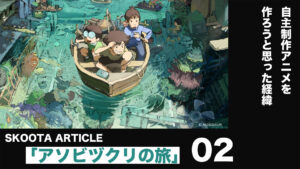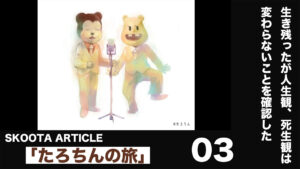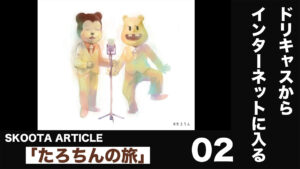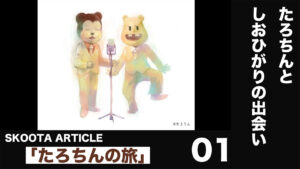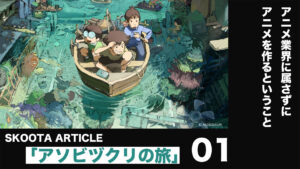Guest, Personality
Guest: Mirai Mizue
Animation Artist
Born in Fukuoka, Japan in 1981, this animation artist creates non-narrative expressions using motifs such as “cells” and “geometric shapes”. He is known for their unique and captivating abstract animations and have worked on a wide range of projects including independent animation and music videos.
He has been nominated for all four major animation film festivals in the world (Annecy, Ottawa, Hiroshima, and Zagreb), and their masterpiece “MODERN No.2” premiered at the Venice International Film Festival and won the music award at the Annecy International Animation Film Festival.
“WONDER” premiered at the Berlin International Film Festival and won the CANAL+Creative Aid Award at the Annecy International Animation Film Festival. They are currently preparing to produce their first feature-length animation, “Mizue Saiyuki” (tentative title).
Personality: Yuuki Sakoda
After working for a telecommunications company and a comprehensive advertising agency, he started an anime planning and production company and produces music videos and films. In 2021, he moved to Kyoto and started working on promoting the entertainment industry in Kyoto. He is currently also working in the entertainment field of manga and audio. He is planning and producing audio dramas and webtoons. In addition, he serves as a producer and advisor for multiple entertainment companies.
Table of Contents
#01
What is non-narrative expression in animation?
My work was screened in the non-narrative section at a film festival.
It’s not about having no “story” but rather not placing the “story” as the core of the work.
I continue creating what I like without worrying about genres.
Falling hurts, and soft things feel comfortable.
From Jurassic Park and Terminator to the Lumière brothers.
Movies are not just about stories but also about moments of experience.
I love the unforgettable experiences scattered throughout films.
On a summer day, playing a monster movie director game, mimicking an industrial complex in a vinyl pool.
Memories of watching Return of the Jedi in the theater.
Growing up with parents who loved movies.
Standing in line to watch The Phantom Menace as a high school senior.
A longing for the analog theater space.
The shock of seeing T-1000.
A desire to see the strange and unusual.
From an ETERNITY interview.
Creating something experimental and bizarre in a short duration.
A ride-type experience to make a non-narrative piece that won’t let you sleep for 20 minutes.
Realizing you were in a movie theater when the movie ends.
The night of a bicycle sprint after watching ET.
#02
Watching subjective visuals on a large flat screen becomes VR.
The pleasure of visuals in “Spider-Verse.”
The value of non-verbal expression.
The ambiguity when communicating with words.
Words from a woman in Germany who watched “WONDER.”
Non-verbal expression may have the power to make viewers think spontaneously.
Dislike for surveys.
Talking about “Fraggle Rock.”
About “Mizue Saiyuki (tentative).”
The significance of doing Journey to the West now.
How humans live and perceive the world.
#03
About “License of Love.”
Introducing many characters.
The theme of expanding on life and death.
Inspired by science books from Gakken that I read as a child.
About the music by Twoth.
Twoth also created music for Into Animation 8.
The program of Into Animation 8.
Animation is becoming more interesting.
Anime is starting to cross boundaries, becoming chaotic but exciting.
To introduce many characters
Sakoda
First of all, starting with the discussion about “ETERNITY” being VR, from my perspective as a VR enthusiast, we have been deepening the discussion about VR challenges. Currently, we are focusing on the long-form challenge, specifically about “Mizue’s Journey to the West”. So, I would like to continue the conversation regarding “Mizue’s Journey to the West”. Well, in terms of expression, it was mentioned that the strength of Mizue lies in the expression she is currently using, and the original work that can make the most of this expression is “Journey to the West”. This applies to both the story and the underlying Buddhist motifs. For example, the metamorphic expression used to convey the concept of impermanence seems to strongly represent the idea that “everything is constantly changing”.
In order to recognize oneself, it seems that one needs to consider oneself as something other than what has recognized everything else. I think this idea is intuitively and visually incorporated into this visual expression. In that sense, it seems to be a very compatible combination. I also think that people from India, for example, might say, “Ah, this is it!” I thought this because the current leader of Indian Buddhism is Japanese, and it’s an area that I have recently been interested in, so I tend to interpret it in that context.
Regarding the point that there are many characters, if I may ask, in terms of the characters, although I think they are composed in text in the plot, is it Mizue who is responsible for character design?
Mirai Mizue
Well, currently I’m working on creating a pilot version of the video, and I am the one designing the characters that appear in it. I still don’t know exactly how they will evolve in the end.
Sakoda
I see. Well, I really like the cute characters that are depicted in Mizue’s work, so I want to see it. For example, the characters in CHAI’s music video “Aisouze!” or characters based on the members of CHAI, and also cute characters that are kind of dinosaur-like, they are really good.
Also, I really like kiki vivi lily, so while watching the music videos of Tomggg and kiki vivi lily, I think the characters are cute. I’m excited, wondering if these characters will appear and the story will unfold.
Mirai Mizue
kiki vivi lily and Tomggg’s work is an animation where the eyes move chaotically. It’s like there’s a canvas of abstract animation inside the eyes. It’s basically a music video created as a lyric video, so it loops continuously. We wanted to create a part with a high density somewhere in the short animation, so we decided to do it in the eyes. The characters that appear in the music video are similar to those from “Journey to the West,” and that’s what I’m currently drawing. Wanting to create many characters is definitely influenced by “Fraggle Rock” and also by characters like those that appear for a moment in a scene in “Star Wars.” Another thing is that I really love “The NeverEnding Story.”
Sakoda
Ah, “The NeverEnding Story,” is it? Yes, I see. Indeed, I thought so too. It’s something that crossed my mind just now, as you mentioned it.
Mirai Mizue
“The NeverEnding Story” is completely different from “Star Wars” because various characters appear, so I really like it. So, definitely influenced by such things. In “Chibi Maruko-chan”, for example, there are no background characters, but all the classmates have unique personalities and backgrounds. As for “Doraemon”, except for Nobita, Gian, Suneo, and Shizuka, everyone else becomes a background character. I really like how all these characters appear in a way that everyone can become the protagonist. That’s the feeling I have when I think about it now.”
Sakoda
As Mizue mentioned, it’s the subtle details such as the number of characters, their outfits, and the world-building through backgrounds that create the overall atmosphere. That’s why I feel a strong desire to increase the pressure in those aspects. Without them, the world-building somehow fails to become richer.
Mirai Mizue
I wonder what that is. In life, as it progresses, we naturally come into contact with various people, and the intensity of those interactions varies. For example, when we meet people at a film festival, during that week we greet each other and have conversations. But once the festival ends and we say “goodbye,” there’s a possibility we may never see each other again. When I think about meeting and parting ways with so many people, never to intersect in my own life, it makes me realize that these kinds of things happen every day. I guess you could say that life and death are constantly intertwined.
This particular work is created with a lot of contemplation on life and death. The idea of dying can be incredibly frightening when I imagine it on my own, but at the same time, there are moments when life expands as I think about things that have made me happy, conversations with my family, or envisioning the future.
So, the fear of death is magnified, and at the same time, there seems to be an expansion of life happening, which complicates things within myself. I feel like I used to live a simpler life in the past, but now the concepts of living and dying have become incredibly complex and expanding simultaneously. This sensation exists within me, and I have incorporated it as a theme in this work.
Sakoda
After listening to the current story, the resolution of “Mizue Saiyouki” has greatly increased within me. Although in some places I still can’t tell if it’s natural or intentional, within the things that Mizue-san is outputting to the world, there are definitely things like the Thousand-Armed Kannon, Yakushi Nyorai, Amida Buddha, or even something like the god Shiva. Various motifs like these are depicted, and I can’t help but feel drawn to such things. It’s like there’s a gravitational pull towards them. It’s like when contemplating “life and death,” it naturally leads in that direction.
Mirai Mizue
Well, in my case, when I was a child, I used to read the Gakken science books. I would read the Gakken science magazine every month. And well, in there, I would see things like the world inside a microscope, the world of space, kits to test acid rain, and information about deep-sea creatures. I would get really excited while reading about those things.
So, my interest in life and death comes more from a scientific perspective. I’m scared of dying, but on the other hand, I wonder why I’m alive right now, and why my life continues during this period. Basically, I think about what it means to not exist, and how it’s actually rare to exist. When I think about how the universe exploded and our solar system and Earth came from the dust within that explosion, and if I imagine going beyond the expanding universe, I wonder if there is just an empty space spreading out. In that case, the state of there being something is actually a very mysterious state. It’s like, there’s this part where my imagination starts to expand.
Sakoda
Maybe, I still feel like I don’t have enough weapons to cut into Mizue-san’s world, and I feel like I have a lot of shortcomings in my role. But I’m glad I’ve been able to ask you a lot of questions. Um, for now, I’d like to insert that song here, and as for the second half, this long piece is the same, but I’d like to talk about the upcoming INTO ANIMATION film festival.
Um, before that, I’ll have you listen to a song, but earlier, there were encounters and farewells, and there was also a discussion about existence and non-existence, and there was also a discussion about life and death. Mizue-san, I think you’ve been through many joys and sorrows with various members up until now, so this song is related to those people.
Mirai Mizue
The person who created the song for my animation “MODERN No 2” is an artist named Twoth. They are a musician and they are also creating the music for the opening video of the INTO ANIMATION 8 screening event. Please listen to the song “Roudou Sanka” by Twoth.
About Twoth’s music
Sakoda
Yes. So what you just listened to is “Roudou Sanka” by Twoth. Well, Twoth is perfect for talking about INTO ANIMATION, and they have also created music for INTO ANIMATION. I wonder if there are various episodes as comrades with different people.
Mirai Mizue
Yeah, that’s right. So, as Twoth mentioned, their real name is Shinichi Suda, and they also release music under the name Shinichi Suda. Since “Twoth” can be a bit difficult to pronounce, I’ll refer to them as Suda from now on. Suda mentioned that when creating their own songs, they approach it with an animation-like perspective. They view their music as animation. In addition to the song “Roudou Sanka,” Suda has created many different experimental tracks. They have also collaborated with vocalist Bonjour Suzuki and have a playful and mischievous element throughout their music. When listening to their songs, there is a sense of excitement and wonder in the various sounds. This aspect is somewhat similar to the animations I create. In my case, the actual shapes and colors move to evoke cuteness. However, in Twoth’s case, their music itself, each individual sound, has a character-like quality that stands out as a distinctive feature.
Sakoda
Even now, while listening to Twoth’s story and doing a little research, you know, about that. Regarding Mr. Mizue, there is also collaboration with the Kyoto City Zoo. Well, you know, the Kyoto City Zoo is right nearby, and I often go for walks there, about a 5-minute walk away. I thought that the chimpanzees there had composed that song. Well, even though it’s a bit strange to talk about the Kyoto City Zoo, they really put a lot of effort into the great apes, don’t they? In terms of human understanding, it’s a song that makes you wonder how to interpret it, but it’s quite interesting. And it turns out that Twoth is in charge of the opening song for INTO ANIMATION this time.
Mirai Mizue
Well, I see. You’re creating the opening animation song, right? So, um, it’s also a promotional video, and as an announcement video, um, it hasn’t been announced yet, like on the internet or anything. But soon, as part of the announcement video, the music will be available to listen to.
Sakod
INTO ANIMATION itself is scheduled to take place from August 4th to August 7th this year, 2023. It will be held at the National Art Center. Could you please provide more information about the event?
About the program for Animation 8
Mirai Mizue
INTO ANIMATION is the Japan Animation Association, of which I am currently the chairman. It consists of various members such as animation creators, producers, researchers, and individuals involved in animation education. The first chairman was Osamu Tezuka.
The current organization started in 1978, and INTO ANIMATION is an event held approximately once every few years. It is a screening event where members can showcase their own works. Therefore, the works shown are primarily short films. Among these short films, there are original works, music videos, and animations for children’s programs, among others.
Sakoda
Is it okay for anyone to enter during that time?
水江未来
This is free admission, right? If I counted correctly, there are about 150 works in total, so you can see about 150 works if you go for all four days. That’s quite a volume. They are showing animation films pretty much all day long.
There are five programs in total, mainly focusing on new works. Each program has a different theme, such as fantasy, adventure, technique, human drama, and family. They have categorized the member’s works under these themes and are screening them. In addition to that, they have special feature programs, such as a program featuring short films by Taku Furukawa, the honorary chairman of the Animation Association, and a talk program discussing the achievements of Yasuo Otsuka. They also have a program featuring animations from the 90s.
They also have a program called “Animation for Meditation,” where experimental animations are screened as a meditative experience. Furthermore, there are various other programs, such as an independent animation program by the Korean Animation Association called KIAFA, and a program featuring stop-motion animations.
It’s not just screenings, there is also a program called “Animation Study,” which is organized by the researchers. They introduce the Nippon Connection, a Japanese film festival held annually in Germany. There are also collaboration programs, where various creators collaborate to create a single film that is then screened and explained. Additionally, there is a dialogue between two authors, Ryoji Yamada and Hiroyuki Morita. Well, there are many more programs.
Sakoda
There are many, aren’t there? But from what I can tell, there are various things that transcend different eras, such as a discussion on 90s animation and an anime discussion that predicts the anime scene in the 2020s. There are also things like Germany and South Korea, and I wonder what the Toranoana screening event is all about.
Mirai Mizue
Bring-in screenings are screenings where young students or people who have just started making animations can bring in their works and screen them here. It is a screening event where members of the Animation Association also provide comments. Director Sunao Katabuchi, who directed “In This Corner of the World,” is also a member of the Animation Association, and he will provide comments.
Anime has started to cross over and it is chaotic, but it is also exciting.
Mirai Mizue
In considering the program this time, what I realized is that the animation works created by the members of the Japan Animation Association are different from the animation produced by commercial studios. When it comes to Japanese animation, the image is often associated with animation produced by commercial studios, but when we look back at its history, there have been many animations created by individuals, starting from the early days of television stations. There has always been a long history of animations produced on an individual basis.
In organizing the program this time, I feel that it is expanding in various directions and that the animations created by the members of the Japan Animation Association can present a great diversity in terms of experiencing various animation expressions in this current era. That’s the feeling I have while working on it.
Sakoda
Certainly, there are members who have experienced various eras of animation, including newcomers. As you mentioned, recently the output using the expression “anime” has expanded and established itself as an industry through commercial and market principles. From that perspective, the movement from late-night anime can be seen as anime, but from a commercial standpoint, it may be true. However, there have been various things using the expression “anime” for a long time, and being able to see them all at once allows us to see the various possibilities that anime has in a comprehensive way, which is really great.
I think it connects to the discussion about the previous words being inadequate. When talking about anime in a nutshell, it may be different to divide it by age, but to put it simply, when talking about anime in the 90s and when talking about anime in the 2020s, even if they are talking about the same anime, completely different images come to mind. It’s a bit off topic, but it often happens, especially in the case of work received from clients.
Mirai Mizue
Yes, yes. That’s right. There are, there are. The client or agency is saying something like “What do you mean by anime-style?”.
Sakoda
Yes, indeed. It starts with the turn to clarify. But that’s also an expression of how the word “anime” has become common and well-known among people.
Mirai Mizue
Yes, that’s right. Recently, when talking to students, there are even people who say they only watch Cartoon Network, for example. Some people are not interested in Japanese anime and only watch Cartoon Network, and they really love it. It seems like things are becoming more and more specialized. Interests are diverging, and the number of people watching the same thing in common is decreasing. It’s the era we’re living in, isn’t it?
Sakoda
No, that’s right. Well, I guess during the time when there was a living room and people watched TV, anime was definitely a common experience for everyone. In the discussions I’ve had with INTO ANIMATION, I learned that in Episode 3, Miku Mizue’s past is connected to her parents’ film education, and how that has led to where she is now. Although it’s still unclear how many years into the future it will be, it was very enjoyable for me to hear about her challenge in creating feature-length animations. Personally, I have a particular interest in delving into the details of the music videos being produced, so I would be delighted to hear more about that somewhere down the line.
Mirai Mizue
Please, please, I beg you.
Sakoda
Finally, if there is anything you would like to convey or discuss, whether it relates to INTO ANIMATION or any other topic, please feel free to do so. We would appreciate it if you could share any thoughts or topics you would like to discuss. Thank you.
Mirai Mizue
Well, you know, right now, there are so many different things in animation that everyone is watching, like the story that just came up. Each person has their own preferences and is watching what they like, and it’s becoming more and more specialized. I don’t know how it’s going to evolve in the future, though. But now, even in the production of animation, it feels like the walls are gradually disappearing. In other words, it’s not a division between commercial studios and independent artists, but rather people who were independent artists are now working as directors in commercial studios.
In short, young creators who create things on SNS are starting to make more and more music videos, and they are creating works that have a commercial animation look but also incorporate the unique directing style that can only be achieved when working individually, without being affiliated with a commercial studio. There is even a movement called “#IndieAnime” that has emerged. And stop-motion animation is also highly compatible with SNS. Moving figures, visual surprises, and the buzz that comes from them. Animation is currently in a very interesting era, I think. In the past, there was not much interaction between different genres, but now it’s starting to happen.
Well, I don’t know what will happen from here, but I think it’s a very exciting time. Although, with the emergence of AI, it’s becoming even more chaotic. It’s a time of chaos, isn’t it? So, while enjoying the chaos, I want to continue creating. So, for those who are currently making animation or videos, I think it would be nice if they could enjoy the various changes that will happen in the future.

